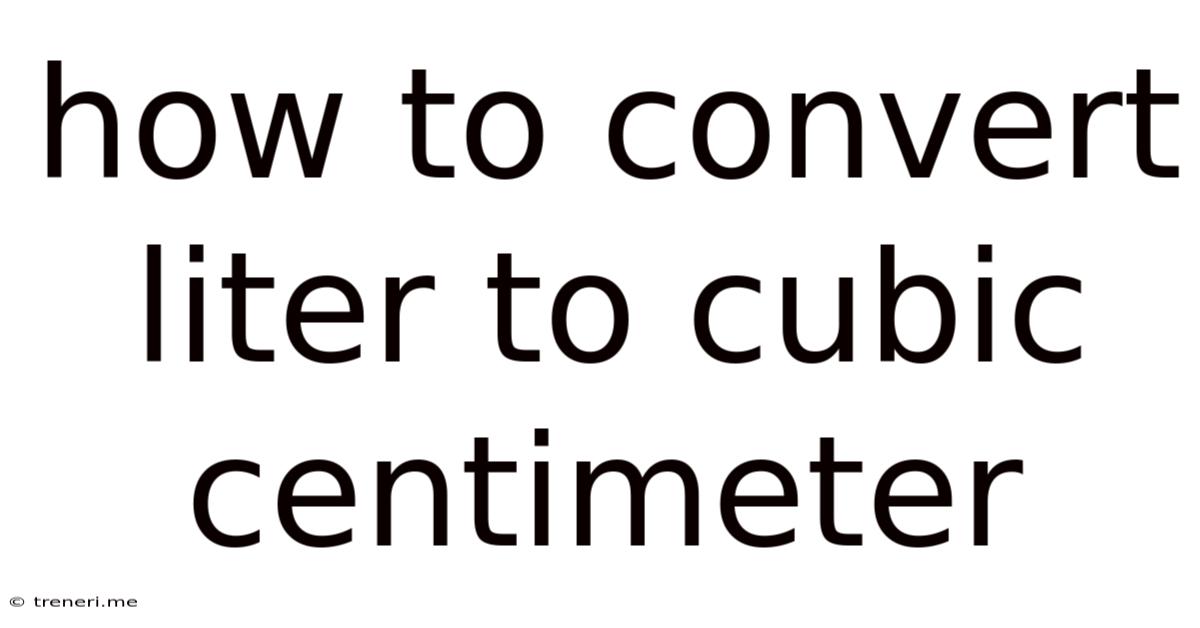How To Convert Liter To Cubic Centimeter
Treneri
May 10, 2025 · 4 min read

Table of Contents
How to Convert Liters to Cubic Centimeters: A Comprehensive Guide
Converting liters to cubic centimeters (cc or cm³) is a fundamental task in various fields, from chemistry and physics to engineering and cooking. Understanding this conversion is crucial for accurate measurements and calculations. This comprehensive guide will not only explain the simple conversion process but also delve into the underlying principles, provide practical examples, and explore the broader context of volume measurement.
Understanding Liters and Cubic Centimeters
Before diving into the conversion, let's establish a clear understanding of the units involved:
Liters (L)
The liter (L) is a metric unit of volume. It's a commonly used unit for measuring liquids and gases. While not an SI base unit (the SI base unit for volume is the cubic meter), it's widely accepted and understood globally. One liter is defined as the volume of a cube with sides of 10 centimeters each.
Cubic Centimeters (cm³ or cc)
The cubic centimeter (cm³), also known as a milliliter (ml), is a unit of volume representing the volume of a cube with sides of 1 centimeter each. This makes it a smaller unit of volume compared to the liter. The abbreviation "cc" is often used in medical and engineering contexts.
The Conversion Factor: The Heart of the Conversion
The key to converting liters to cubic centimeters lies in understanding their relationship. Since a liter is defined as 10cm x 10cm x 10cm (a cube with 10cm sides), it's essentially 1000 cubic centimeters.
Therefore, the conversion factor is:
1 liter (L) = 1000 cubic centimeters (cm³) = 1000 milliliters (mL)
This simple equation is the foundation for all liter-to-cubic-centimeter conversions.
How to Convert Liters to Cubic Centimeters: A Step-by-Step Guide
The conversion itself is straightforward:
Step 1: Identify the volume in liters.
This is the starting point. Let's say you have 2.5 liters of water.
Step 2: Multiply the volume in liters by 1000.
This is where the conversion factor comes into play. In our example:
2.5 L * 1000 cm³/L = 2500 cm³
Step 3: State the result in cubic centimeters.
Therefore, 2.5 liters is equal to 2500 cubic centimeters.
Simple Formula:
Volume in cm³ = Volume in L * 1000
Practical Examples: Real-World Applications
Let's explore some real-world scenarios where this conversion is vital:
Example 1: Medical Dosage
A doctor prescribes 50 mL of medicine. To determine this in cubic centimeters, you would use the conversion:
50 mL = 50 cm³ (Since 1 mL = 1 cm³)
Example 2: Engine Displacement
The displacement of a car engine is often expressed in liters or cubic centimeters. If an engine has a displacement of 2.0 liters, you can easily convert it to cubic centimeters:
2.0 L * 1000 cm³/L = 2000 cm³
Example 3: Cooking and Baking
Recipes might specify liquid ingredients in milliliters or liters. Converting to cubic centimeters can be essential for accurate measurements, especially when using measuring tools calibrated in cubic centimeters. For example, if a recipe calls for 250 mL of milk, that’s equivalent to 250 cm³.
Example 4: Scientific Experiments
In scientific experiments involving liquids, precise volume measurements are critical. Converting between liters and cubic centimeters ensures the accuracy required for reliable results. For instance, if an experiment requires 0.75L of a solution, you’d convert it to 750cm³ for precise measurement using appropriate lab equipment.
Beyond the Basics: Understanding Volume and Units
This section will explore the broader context of volume measurement and its relation to other units:
Cubic Meters (m³)
The cubic meter (m³) is the SI base unit of volume. It's a larger unit than both liters and cubic centimeters. The conversion factors are:
- 1 m³ = 1000 L
- 1 m³ = 1,000,000 cm³
Cubic Millimeters (mm³)
A cubic millimeter (mm³) is a smaller unit of volume than a cubic centimeter. There are 1000 cubic millimeters in 1 cubic centimeter.
Gallons (gal) and other Imperial Units
While liters and cubic centimeters are metric units, it's important to be aware of other volume units used in different systems, like gallons (US gallons and Imperial gallons) and fluid ounces. Converting between these systems requires different conversion factors.
Tips and Tricks for Accurate Conversions
- Use a calculator: For larger numbers or more complex conversions, a calculator can significantly simplify the process and minimize errors.
- Double-check your work: Always verify your calculations to ensure accuracy. A small error in conversion can significantly impact the results in various applications.
- Understand the context: The choice of unit depends on the context. Cubic centimeters are often preferred for smaller volumes, while liters are suitable for larger volumes.
Conclusion: Mastering Liter to Cubic Centimeter Conversions
Converting liters to cubic centimeters is a fundamental skill with wide-ranging applications. By understanding the conversion factor (1 L = 1000 cm³), you can easily perform these conversions accurately. This guide provided a step-by-step process, practical examples, and a broader understanding of volume units. Mastering this conversion will enhance your proficiency in various fields, from everyday tasks to scientific experiments. Remember to always double-check your calculations and choose the appropriate unit based on the context of your work. Accurate measurements are crucial for reliable results in any endeavor.
Latest Posts
Latest Posts
-
How Old Will I Be In 2042
May 10, 2025
-
How Much Is 29 Kilos In Pounds
May 10, 2025
-
How Many Days Is 27 Weeks
May 10, 2025
-
How Many Ounces Is 7 Cups Of Water
May 10, 2025
-
Mass Of A Substance Divided By Unit Volume
May 10, 2025
Related Post
Thank you for visiting our website which covers about How To Convert Liter To Cubic Centimeter . We hope the information provided has been useful to you. Feel free to contact us if you have any questions or need further assistance. See you next time and don't miss to bookmark.